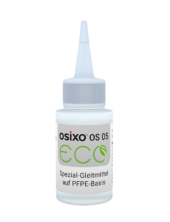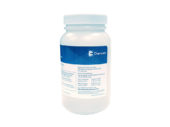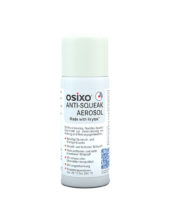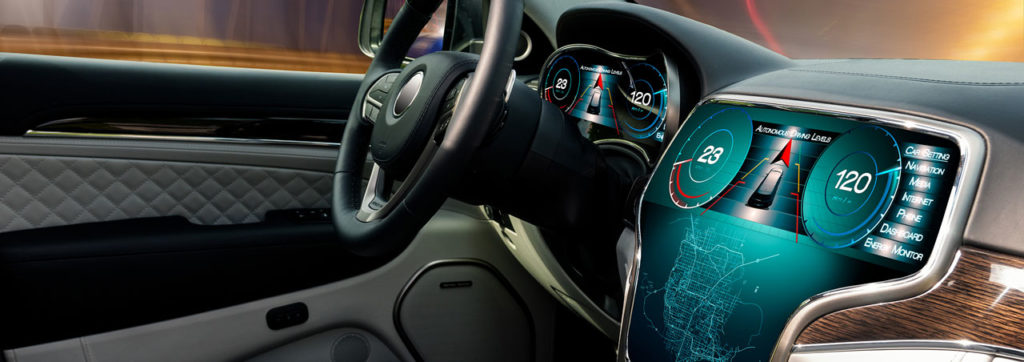
Just imagine you are sitting in a concert hall and a mobile phone rings. Awkward, but not too bad. Unless, of course, it’s your mobile …
Nobody wants to be the person responsible for the fact that other people are irritated by unpleasant sounds. And the same thing which applies to the concert hall has always applied to vehicle interiors.
The especially quiet “mobility of the future” in electrically-driven vehicles increases this awareness further. The acoustic demands are also increasing in commercial vehicles, trains and aircraft due to comfortable and better-insulated vehicle interiors. The avoidance of background noise in vehicle interiors is thus an ever-greater priority in the quality assessments of components and parts.
How interfering noises arise
Interfering noises arise from the relative movement of two components at their point of contact. Vibrations are produced during driving which set the various components in different oscillation modes. These depend on the design of the components and the materials used. The noises produced from this friction are perceived as unpleasant and interfering by the occupants of the vehicle.
Read here how OSIXO OS 05 prevents noise in the interior door panel.
The physics behind the noise: the stick-slip effect
Alongside the vibration noises, the so-called “stick-slip” movements are the main cause of interfering noises. The “stick-slip” effect describes the movement of objects moving against each other. During this, high adhesion and sliding forces occur alternately and cause the typical jerky movements of the two elements rubbing against each other. These are the cause of noises considered to be irritating such as squeaking and creaking. Classical examples are squeaking rubber seals when opening and closing windows and the typical creaking of leather.
Sensitisation and quality perception
Motor vehicles have become increasingly more comfortable and quieter in recent years. Passengers notice noises in the vehicle interior even more nowadays due to improved insulation of engine and rolling noise. The new mobility with its almost noiseless drives increases this effect even more. The related customer requirements increase at the same rate as the background noise level in the vehicle reduces. This means that squeaking and rattling noises are increasingly being perceived as characteristics caused by reduced quality or bad workmanship.
Elimination of these background noises is therefore an important factor for the manufacturer’s image.
Read here how OSIXO was able to solve an acute delivery problem for a manufacturer of trunk rails.
Where disturbing noises occur
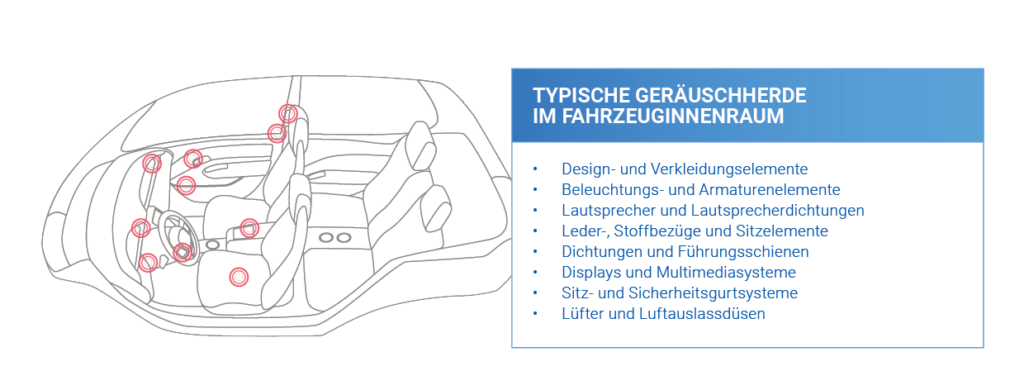
Ventilation: The mother of all noise
The most classic type of all disturbing noises in the vehicle interior is the ventilation. The small fast rotating fan blades are subject to particular challenges. Within only a few minutes they are cooled down from medium double-digit to single-digit range temperatures. In addition, they are exposed to high mechanical loads. The typical “ventilation squeaks” result from the formation of friction points due to material extension.
Displays and touch elements
The digitalization of vehicles requires ever larger and better panels which serve for information and interaction between the driver and the vehicle. They replace the common display and operating elements and have to combine the advantages of both of them: a pin sharp image, a fine sensor system, touch sensitivity up to the recognition of gesture-based commands made above the display without touching. The rapid development generates more and more heavy and sensitive systems which require fitting mounting frames in the panel. The contact between the dissimilar materials of the hard and stiff glass display and the relatively flexible plastic mounting frame is the reason for the emergence of interfering noise.
Claddings und design elements
Cars, especially those of the high-priced category, do not sell by rational arguments. They sell via emotions. And it is the task of vehicle designers to arouse them. Thus, the design elements in and at a car are not chosen by chance but follow a certain concept which matches the desired image of the vehicle and the brand. The designers are rather reluctant to allow the constructors restrict them in what they are doing. The wishes and demands of the creative designers often drive the constructors to the brink of what is possible.
Seamless transitions of matt and flexible materials to stiff high-gloss elements, leather applications, twisted design components and precisely fitting operating elements are a challenge for construction and assembly. The more closely the components are located to each other the more often interfering noise occurs under the influence of temperature and vibration.
SPA instead of spartanic
The vehicle interior is increasingly becoming an oasis of well-being, a place for relaxation. Manufacturers rely on indirect ambient lighting and design elements that radiate calm. Music sounds in the highest quality from more than a dozen speakers. All elements should merge seamlessly and appear as one optical unit. But all this also leads to more friction points and more noise sources. Ambient lighting in particular places high demands on the material. Here there are a large number of friction points between light guides and brackets, which under unfavorable circumstances can develop into noise sources. Translated with www.DeepL.com/Translator (free version)
Seals play first violin in the concert of silence
They protect the interior from outside noise but can also be a possible source of noise themselves.
Seals have to fulfill a number of very high requirements. They need strong stability against external influences like wind and weather, heat and cold, aggressive cleaning agents and fuel. Apart from that they need to optimally adapt to specific constructional conditions. Seals have to be flexible enough to absorb the movements of the vehicle but also need sufficient stability to protect the interior from liquids and vapors. What is more, they must not adhere to each other or to other surfaces and have to maintain their structural integrity.
Modern elastomers master a large variety of these requirements very easily. Wherever they may have deficits, special coatings come into play.
Coatings serve to protect the seals and support their functionality. They help to make the material more resistant to cleaning agents, UV rays or aggressive chemicals. Coatings provide sustainable flexibility and prevent the seals from curing and becoming brittle and chapped.
However, the coating or selective covering of seals or single sealing points is no sign of minor product quality. It is rather like in every good concert: The mixture and the finely tuned interplay of single instruments define the quality of the music.
Diverse solutions for a multifaceted problem
There are only two serious possibilities for the effective prevention of interfering noises: The prevention of any contact by a larger gap dimension or the reduction of the friction resistance by surface treatment. While the first possibility is subject to numerous optical or functional reservations, the coating of the relevant surface does not have optical, haptic, technical, qualitative or quantitative limitations. Coatings can also be used in every production phase and are also suitable for reworking.
Design solution
Increasing the gap size can be a suitable method of frictional noise avoidance. However, this is a costly process with considerable influence on the construction and design of the vehicle interior. On top of this, large gaps are not considered aesthetic and spoil the overall interior appearance. In addition, some frictional locations and noise sources cannot be rectified by design measures for reasons of their character. Furthermore, structural elimination does not support short-term solutions. They always require a certain level of preparation time and can only be theoretically assessed for their effectiveness in advance.
Chemical-technical solution
Normally, oils, greases or coatings are the preferred choice. Which product is suitable in this respect depends on the environmental conditions, the material used and the location of the application. Products in the OSIXO® ANTI-SQUEAK range have an obvious competitive advantage in this case: most products in the series are based on PFPE/PTFE. This is chemically inert and does not react with the treated material. As a result, it can be used without hesitation on virtually all materials in vehicle interiors.
A new way: active suppression of rolling and driving noises
Currently, efforts of component and vehicle manufacturers are going further. Alongside the better insulation and prevention of interfering noises, systems are being developed that actively suppress these noises. Sensors record the driving noises of the vehicle and speaker systems in the interior respond to them with appropriate cancelling noises. The problems for the designers of vehicles remain, however: the less the passengers in the interior are aware of the noises from outside, the more attention must be paid to the prevention of interfering noises in the vehicle interior. And the increased number of components in the interior does not help in this respect.
Selection criteria: finding the right product
Each application is special and has to be subject to an individual check. The large number of factors that influence the selection of the correct material only allow universal statements about the suitability of a product to a limited extent. Despite this it is possible to provide relatively accurate forecasts and preselect a suitable product.
Compatibility and tolerability: It is extremely important to match all the materials used together. The products must be compatible with the treated surfaces and materials in the long term.
Analysis of the environmental conditions during application and during later use: Influencing factors such as temperature loading, impurities caused by dust and dirt, water or cleaning agents are fundamental for the product efficiency.
Practical considerations on application: Will the application be made at an easily-accessible location? Is removal necessary for any required post-treatment? Will an application system be required? All these questions play a part in the selection of the optimum product.
The duration of the application: Are we dealing with a short-term assembly aid or a rapid problem solution? Or is the material used intended to provide lifetime permanent lubrication?
Appearance, haptics and perception: The secondary product properties are in the foreground in this case. Even an optimally-functioning method cannot be applied if it has a negative influence on quality perception. The question always arises: Are the products used in visible or non-visible areas of the vehicle interior? Is the product to be used colour-neutral? Will the functionality or the movement of components be influenced by the material used? Or is the material used intended to even minimise or promote movement?
Further, special requirements for the product used:
One example of this is the inspection capability of the coating using a UV tracer.
Selection of the correct lubricant type
In addition to the selection of the optimum product, the product’s physical condition can also be decisive for its success.
An aerosol is recommended if a low quantity is to be applied over a large surface area without pre-treatment. Aerosols are also the preferential choice if we are dealing with the coating of angled components or components with difficult accessibility. Aerosols are also particularly suitable for post-working.
Oils are recommended for the application of higher layer thicknesses than are possible through the use of aerosols. Oils are also particularly suitable for elastic substrates. Oils can be used for coating leather and elastomers, for example. Oils are particularly suitable for pinpoint and economical application through the use of special applicators.
Greases are recommended if an extremely high layer thickness is to be achieved. Greases are also used at locations at which oils do not bond sufficiently and the application of a coating is not possible. They are also used for particularly highly-loaded surfaces in non-visible areas. They are used if frictional values are to be influenced in a defined manner or movements are to be damped.
Coatings are recommended for low layer thicknesses. Here, the treated material must be suitable for application of the coating. Strongly absorbent materials or materials with a high mechanical loading are less suitable for the application of coatings. Coatings provide permanent treatment of the surface at locations which are difficult to access after installation.

